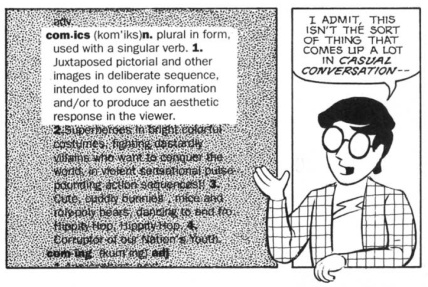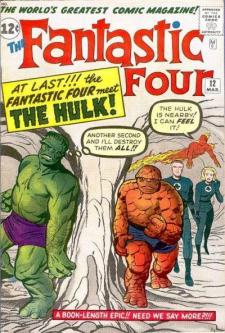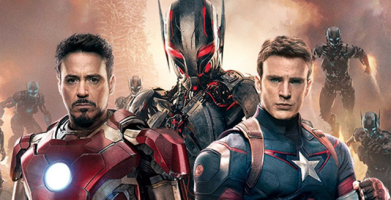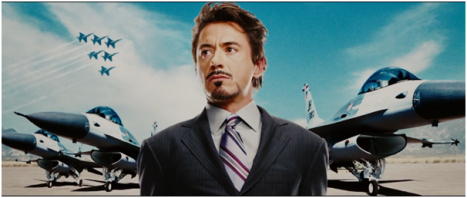 Having just reread Scott McCloud’s Understanding Comics: The Invisible Art, the 1993 watershed book that broke open the field of Comics Studies, I was struck by this short but sweet statement: “Comics IS a sight based medium.” My next thought: if comics are sight based, I’ll bet they’re MIMETIC!
Having just reread Scott McCloud’s Understanding Comics: The Invisible Art, the 1993 watershed book that broke open the field of Comics Studies, I was struck by this short but sweet statement: “Comics IS a sight based medium.” My next thought: if comics are sight based, I’ll bet they’re MIMETIC! 
MIMETIC THEORY is certain to shed all sorts of light on why thousands of Americans, McCloud included, are hooked to comics. As McCloud says: “I felt there was something lurking in comics… some kind of hidden power.” In Co-Mix: A Retrospective of Comics, Graphics, and Scraps, Pulitzer Prize comic artist, Art Spiegelman identifies a “‘secret language,’ of comix — the underlying formal elements that create the illusions.” Comics may be site based, but there’s more to this medium than meets the eye…
Let’s take a closer look beginning with McCloud’s definition of comics:
Comics IS juxtaposed pictorial and other images in deliberate sequence, intended to convey information and/or to produce an aesthetic response in the viewer. (Understanding Comics, 9)
 Right off the bat McCloud’s definition is met with criticism. For instance, Dylan Horroks in “Inventing Comics” astutely and rightly points out that —
Right off the bat McCloud’s definition is met with criticism. For instance, Dylan Horroks in “Inventing Comics” astutely and rightly points out that —
By saying, ‘This is comics,’ Scott is really saying: ‘This is what comics should be; it is what we should value most about them.’ On the other hand, he’s also saying what comics should not be, and, by implication, what we should value less about them.
 But we don’t have to subscribe to McCloud’s definition, as THE only definition, to explore Understanding Comics insights. For starts, McCloud’s definition takes its inspiration from Will Eisner’s famous classification of comics as Sequential Art: “comics employ a series of repetitive images and recognizable symbols. When these are used again and again to convey similar ideas they become a language — a literary form, if you will. And it is this disciplined application that creates the ‘grammar’ of Sequential Art.” (Eisner, Comics and Sequential Art)
But we don’t have to subscribe to McCloud’s definition, as THE only definition, to explore Understanding Comics insights. For starts, McCloud’s definition takes its inspiration from Will Eisner’s famous classification of comics as Sequential Art: “comics employ a series of repetitive images and recognizable symbols. When these are used again and again to convey similar ideas they become a language — a literary form, if you will. And it is this disciplined application that creates the ‘grammar’ of Sequential Art.” (Eisner, Comics and Sequential Art)
 McCloud, a comic book artist in his own right, uses the comic medium to graphically illustrate how the mind processes this grammar. Understanding Comics is actually written like a graphic novel. The results are as illuminating as they are fascinating! Beginning with his visual treatment of “images in deliberate sequence,” Eisner’s “sequence of frames,” McCloud reveals one of comics’ most important hidden powers:
McCloud, a comic book artist in his own right, uses the comic medium to graphically illustrate how the mind processes this grammar. Understanding Comics is actually written like a graphic novel. The results are as illuminating as they are fascinating! Beginning with his visual treatment of “images in deliberate sequence,” Eisner’s “sequence of frames,” McCloud reveals one of comics’ most important hidden powers:
See that space between the panels? That’s what comic aficionados have named the gutter, and despite its unceremonious title, the gutter plays host to much of the magic and mystery that are at the very heart of comics. Nothing is seen between the two panels, but experience tells us something is there! Comics panels fracture both time and space, offering a jagged, staccato rhythm of unconnected moments, but closure allows us to connect these moments and mentally construct a continuous, unified reality… in a very real sense Comics IS closure. (Understanding Comics, 66)
 McCloud insists that unlike film, in which CLOSURE is INVOLUNTARY because the sequence of frames goes undetected, in comics CLOSURE is anything but involuntary. “Every act committed to paper by the comics artist is aided and abetted by a silent accomplice… All of you participated in the murder. All of you held the axe and chose your spot.” (68) He goes on to claim that ” closure in comics fosters an intimacy surpassed only by the written word.”
McCloud insists that unlike film, in which CLOSURE is INVOLUNTARY because the sequence of frames goes undetected, in comics CLOSURE is anything but involuntary. “Every act committed to paper by the comics artist is aided and abetted by a silent accomplice… All of you participated in the murder. All of you held the axe and chose your spot.” (68) He goes on to claim that ” closure in comics fosters an intimacy surpassed only by the written word.”
McCloud could not be more correct, except on one point: that intimacy is itself aided and abetted by unconscious, pre-reflective responses in the brain. Before and below the level of conscious participation, those unconscious mechanisms have already been activated to fill the gaps in the sequence of frames. However we complete the action with the axe, our individual response is not freely chosen, but is determined by an unconscious power lurking within closure: MIMESIS (the unconscious imitation of others). McCloud’s insistence that CLOSURE is a conscious act indicates he has fallen subject to what René Girard terms THE ROMANTIC LIE: the illusion that human beings are autonomous, self-directed individuals. He wouldn’t be the first!
Nevertheless McCloud’s entire thesis need not be overturned. Indeed, if we examine Understanding Comics through the lens of Mimetic Theory (MT), especially as MT intersects with the latest neuroscientific research, McCloud’s best insights take on a whole new life! Vittorio Gallese, one of the neuroscientists to discover MIRROR NEURONS, and connect that discovery with a theory of SOCIAL COGNITION (how we understand each others’ emotions, intentions, and desires), has used this same research to identify the brain structures responsible for MIMESIS:
Goal-directed motor acts are the nuclear building blocks around which action is produced, perceived, and understood…. several studies using different experimental methodologies and techniques have also demonstrated that in the human brain, the neural circuits underpinning action execution directly map its perception when executed by others. These parieto-premotor networks are defined as the Mirror Neuron System (MNS).
 In simpler terms: the MNS is activated by the observation and execution of “mouth-, hand-, and foot-related acts,” or by the “pow” that knocks Batman’s villains flat. This suggests that whenever we read comics, our Mirror Neuron System is activated as the brain’s circuit board responsible for completing the gaps in the sequence of frames. And that’s just the beginning:
In simpler terms: the MNS is activated by the observation and execution of “mouth-, hand-, and foot-related acts,” or by the “pow” that knocks Batman’s villains flat. This suggests that whenever we read comics, our Mirror Neuron System is activated as the brain’s circuit board responsible for completing the gaps in the sequence of frames. And that’s just the beginning:
Even more relevant… is the discovery that the MNS in humans is directly involved in the imitation of simple movements, and the imitation learning of complex skills. (Vittorio Gallese et al, “Motor Cognition and its Role in Phylogeny and Ontogeny of Intentional Understanding,” Developmental Psychology 45 (2009), 103-13)
 When the MIRROR NEURON SYSTEM is engaged, for instance in the act of CLOSURE, a full array of brain phenomena are activated:
When the MIRROR NEURON SYSTEM is engaged, for instance in the act of CLOSURE, a full array of brain phenomena are activated:
- the “chameleon effect” or UNCONSCIOUS MIMICRY of observed postures, expressions, and behaviors
- the perception of ACTIONS as forms of COMMUNICATION
- the ability to READ OTHERS’ INTENTIONS
- the processing of ACTION LOADED WORDS and sentences!
All these brain activities are fired up, unbeknownst to us, in an UNCONSCIOUS collaboration between comic artist and audience! According to Gallese and others the MNS wires us for MIMESIS. From the moment of birth, the human brain, through the observation, interpretation, and imitation of others’ actions, is ever grasping for opportunities to learn the skills necessary for life. 
In much the same way that a small child cannot resist a game of PEEK-A-BOO, we are hooked to comics because the juxtaposed sequence of frames provides our brains with endless opportunities for IMITATION LEARNING.
Gallese says the MIRROR NEURON SYSTEM is just one side of MIMESIS. Its role in mapping actions and intentions can not, on its own, enable social identification or mutual recognition in our relations with others — which will lead us, in the next post to explore another dimension of comics’ hidden MIMETIC powers — the MAPPING of THE FACE. In the meantime, I will leave us with something culled from Dylan Horrocks critique of Understanding Comics:
Understanding Comics is one of my favorite comics. It expresses and explores the same love for comics I’ve always felt but, like Scott, found all but impossible to share with people outside the comics community. It argues persuasively for comics’ limitless potential – that they needn’t be restricted to any particular styles, formats, subject matter or media. And it inspires cartoonists to ever more ambitious creativity – to fearlessly explore uncharted territory.
A potential limited, as is with all great literature, only by Mimesis… ~ Sue Wright
 Why are comics obsessed
Why are comics obsessed




 In a smart cinematic moment, which is signature Joss Whedon, the cameras tilt and the room feels ready to spin out of control. The mimetic rivalry, having gone contagious, as Girard explains it often does, escalates into an ALL AGAINST ALL. All the Avengers are drawn into the heat of the moment. Even Banner is about to lose control and turn into the Hulk. But worse, consumed with each other, the Avengers have lost sight of the real threat: Loki. Lucky for them, Loki chooses to launch an attack. The team is immediately transfigured as they reunite by redirecting the inner conflict outward against
In a smart cinematic moment, which is signature Joss Whedon, the cameras tilt and the room feels ready to spin out of control. The mimetic rivalry, having gone contagious, as Girard explains it often does, escalates into an ALL AGAINST ALL. All the Avengers are drawn into the heat of the moment. Even Banner is about to lose control and turn into the Hulk. But worse, consumed with each other, the Avengers have lost sight of the real threat: Loki. Lucky for them, Loki chooses to launch an attack. The team is immediately transfigured as they reunite by redirecting the inner conflict outward against a common enemy. But you can be sure the tensions will build again. Banner is right: MIMETIC RIVALRY is a time bomb!
a common enemy. But you can be sure the tensions will build again. Banner is right: MIMETIC RIVALRY is a time bomb! Why would Tony Stark, a self-serving, egotistical, playboy billionaire trade in the massive wealth amassed from weapons manufacturing to produce clean, renewable energy and give it away at no cost? Looking back at Iron Man’s first appearance in Marvel’s Tales of Suspense #39 (March 1963), I doubt anyone, not even Iron Man’s creators, could have foreseen Tony’s radical change of heart.
Why would Tony Stark, a self-serving, egotistical, playboy billionaire trade in the massive wealth amassed from weapons manufacturing to produce clean, renewable energy and give it away at no cost? Looking back at Iron Man’s first appearance in Marvel’s Tales of Suspense #39 (March 1963), I doubt anyone, not even Iron Man’s creators, could have foreseen Tony’s radical change of heart.
 Lee modeled Tony Stark after Howard Hughes – the quintessential American capitalist, the epitome of American individualism. Lee’s superhero not only fascinated reader from the start, but now, with Robert Downey’s latest incarnation for the Marvel movies franchise, Iron Man’s power to fascinate has increased exponentially… because without realizing it, Lee fashioned a superhero, whose greatest attribute is not as we might readily assume, Tony Stark’s technological genius or his invincible suit of armor, but his super mimetic powers. As the ultimate ideal of American individualism, Tony Stark presents an irresistible object of
Lee modeled Tony Stark after Howard Hughes – the quintessential American capitalist, the epitome of American individualism. Lee’s superhero not only fascinated reader from the start, but now, with Robert Downey’s latest incarnation for the Marvel movies franchise, Iron Man’s power to fascinate has increased exponentially… because without realizing it, Lee fashioned a superhero, whose greatest attribute is not as we might readily assume, Tony Stark’s technological genius or his invincible suit of armor, but his super mimetic powers. As the ultimate ideal of American individualism, Tony Stark presents an irresistible object of  Iron Man’s mimetic powers become all the more significant when we realize that it’s through Tony’s character that comics’ self-reflection on its role in America’s militarization becomes most heightened. But that’s a topic for another post.
Iron Man’s mimetic powers become all the more significant when we realize that it’s through Tony’s character that comics’ self-reflection on its role in America’s militarization becomes most heightened. But that’s a topic for another post. Every superhero has its arch enemy, a rival which often proves to be the superhero’s undoing. The hero and their nemesis seem to share a special relationship, a kind of mutual obsession or codependency, which exceeds the limits of healthy competition. They are engaged in what Girard identifies as MIMTETIC RIVALRY.
Every superhero has its arch enemy, a rival which often proves to be the superhero’s undoing. The hero and their nemesis seem to share a special relationship, a kind of mutual obsession or codependency, which exceeds the limits of healthy competition. They are engaged in what Girard identifies as MIMTETIC RIVALRY. The imitation back and forth can become so intense, as each is the model to the other, that the hero and his rival may begin to resemble or mirror each other. Batman’s rivals are criminals, so he like them, enshrouds himself in the shadows of the night. Captain America’s rivals are Nazis. Instead of donning a swastika, Cap dons the stars and stripes of the American flag.
The imitation back and forth can become so intense, as each is the model to the other, that the hero and his rival may begin to resemble or mirror each other. Batman’s rivals are criminals, so he like them, enshrouds himself in the shadows of the night. Captain America’s rivals are Nazis. Instead of donning a swastika, Cap dons the stars and stripes of the American flag. 
 But don’t tell Tony Stark! For sure, he’s convinced he is the ultimate self-made individual, the epitome of American ingenuity and autonomy. But the fact is, his identity is constituted by MIMETIC DESIRE, which always has its source in the other. Tony’s being, like ours, is founded in what Girard terms INTERDIVIDUALITY.
But don’t tell Tony Stark! For sure, he’s convinced he is the ultimate self-made individual, the epitome of American ingenuity and autonomy. But the fact is, his identity is constituted by MIMETIC DESIRE, which always has its source in the other. Tony’s being, like ours, is founded in what Girard terms INTERDIVIDUALITY.
 The Joker, played by Heath Ledger, refuses, when he has the chance, to kill his rival. The conflict between the Batman and the Joker, which drive’s the movie’s plot, is by no means a cliche battle between good guy and bad guy, in which both sides seek to annihilate the other. The Joker needs the Batman, he’s fascinated by him, orchestrating ways to get close to the Batman, and insert himself into his life. Remember the Joker’s pivotal line, which on its own, won Heath Ledger the Oscar:
The Joker, played by Heath Ledger, refuses, when he has the chance, to kill his rival. The conflict between the Batman and the Joker, which drive’s the movie’s plot, is by no means a cliche battle between good guy and bad guy, in which both sides seek to annihilate the other. The Joker needs the Batman, he’s fascinated by him, orchestrating ways to get close to the Batman, and insert himself into his life. Remember the Joker’s pivotal line, which on its own, won Heath Ledger the Oscar: This makes total sense in light of Mimetic Theory, what
This makes total sense in light of Mimetic Theory, what  The Batman, mirroring the fascination of his rival, also refuses, when given the chance, to kill his rival. Why is that?
The Batman, mirroring the fascination of his rival, also refuses, when given the chance, to kill his rival. Why is that?  Does this lead the Joker to repent or have a change of heart? The usual cliche movie plot? Not a chance! The Batman’s incredible self-control only makes him more attractive to his rival. But again, the Batman’s autonomous inner source is an illusion, fueled from the start by the Joker’s fascination. As their model-obstacle relationship intensifies on both sides, and each is transfigured by the desire of the other, it’s impossible to say who created who. – Sue Wright
Does this lead the Joker to repent or have a change of heart? The usual cliche movie plot? Not a chance! The Batman’s incredible self-control only makes him more attractive to his rival. But again, the Batman’s autonomous inner source is an illusion, fueled from the start by the Joker’s fascination. As their model-obstacle relationship intensifies on both sides, and each is transfigured by the desire of the other, it’s impossible to say who created who. – Sue Wright





 What actually gives rise to Tony’s ethical conscience? His new found sense of responsibility? Heidegger would say it’s a choice made by the courageous individual. For sure, Tony’s immersion in his protective armor, rather than desensitizing him to the world around him, has made him more aware of his vulnerability as a flesh and blood human being, and with this more responsive to the evils technology so often proliferates, Stark’s own technology included. Surely it’s symbolic that the first
What actually gives rise to Tony’s ethical conscience? His new found sense of responsibility? Heidegger would say it’s a choice made by the courageous individual. For sure, Tony’s immersion in his protective armor, rather than desensitizing him to the world around him, has made him more aware of his vulnerability as a flesh and blood human being, and with this more responsive to the evils technology so often proliferates, Stark’s own technology included. Surely it’s symbolic that the first 








